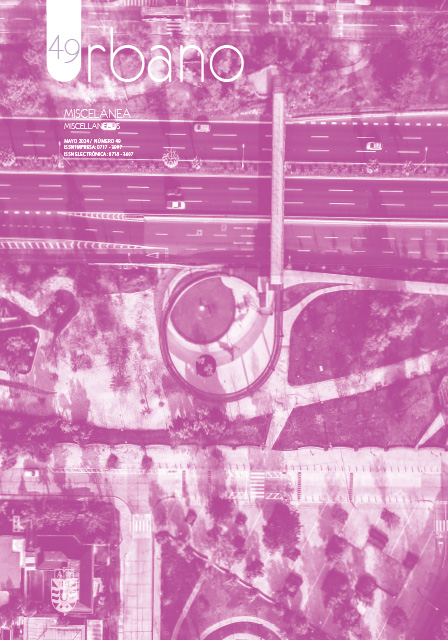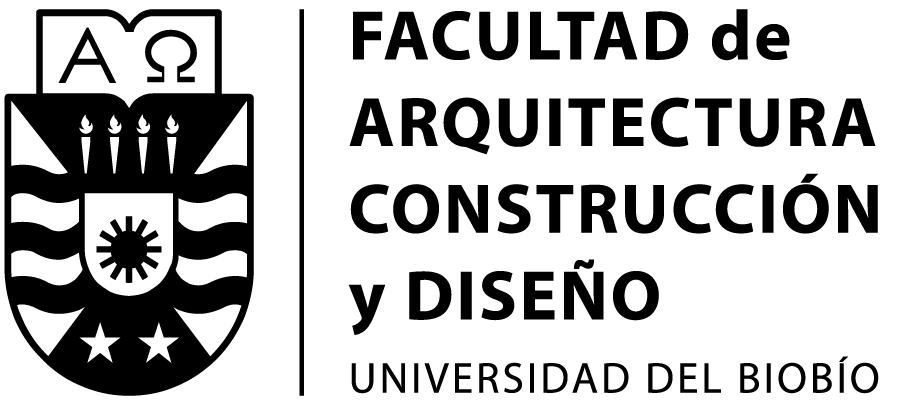Pitrufquén, Chile: la ciudad como estrategia de ocupación territorial
DOI:
https://doi.org/10.22320/07183607.2024.27.49.02Palabras clave:
territorio, historia urbana, trama urbana, arquitectura en madera, arquitectura moderna, ciudadesResumen
El presente trabajo analiza el desarrollo de la ciudad de Pitrufquén (ubicada en la Región de La Araucanía, Chile, fundada en 1897) desde el punto de vista histórico, territorial, urbano y arquitectónico. Se plantea que el devenir de la ciudad se enmarca en un nuevo momento en que el Estado chileno abandona criterios militares y asume factores económico-territoriales donde la presencia del ferrocarril es determinante. La selección del lugar, su particular trazado, así como el desarrollo de su arquitectura, son evidencias de este cambio. Desde el punto de vista histórico, se analiza cómo en el sitio de Pitrufquén, la sociedad mapuche desarrolló la ganadería como actividad económica principal, al contar con praderas para alimentar el ganado, la tierra era apropiada para los cultivos agrícolas y se encontraba allí un importante vado para cruzar el río Toltén. La situación de punto estratégico, se mantuvo y acentuó con la fundación de la ciudad y la llegada de la vía férrea hacia el año 1898, convirtiéndose el poblado en punta de riel, en el avance hacia el sur del país. En el caso de la traza urbana, se abordó su peculiaridad ya que, junto a Lonquimay, constituyen en la región de La Araucanía las únicas tramas ordenadas en base a una elipse que, además en el caso de Pitrufquén, convive con una traza de damero. En el estudio se analizaron sus plazas, avenidas diagonales y la vía de circunvalación perimetral. En el plano arquitectónico, el artículo analiza las tres capas o aspectos de la ciudad: el primero, estudia una de arquitectura en madera con obras de fines del siglo XIX y comienzos del XX; el segundo se refiere a la arquitectura pública, representada por edificios como, la municipalidad, los servicios públicos, el correo y otros, y el tercero capa corresponde a la arquitectura moderna, como vivienda y comercio del período comprendido entre los años 1940 y1960.
Descargas
Citas
ALVARADO, C. (2015). La emergencia de la Ciudad Colonial en Ngulu Mapu: Control Social, Desposesión e Imaginarios Urbanos en E. Antileo; L. Cárcamo-Huechante, M. Calfío y H. Huinca-Piutrin (Eds.), Awükan Ka Kuxankan Zugu Wajmapu Mew: Violencias Coloniales en Wajmapu, (pp. 107 - 140). Ediciones Comunidad de Historia Mapuche. https://www.comunidadhistoriamapuche.cl/wp-content/uploads/2017/05/530100_a0ebc11c30e8433e828df3145bcc4d68.pdf
ANDREATTA, V. (2007). Ciudades cuadradas, paraísos circulares. [Tesis de Doctorado Universidad Politécnica de Cataluña, España]. https://upcommons.upc.edu/handle/2117/94284
ANTIVIL, W.(2023). “La construcción del territorio entre Malleco y Cautín durante el avance del Estado en la Araucanía: reflexiones en torno a cuatro cartografías (1869-1888)”. 2º Seminario Territorio, Ciudad y Arquitectura en la Araucanía Siglos XIX – XX. Universidad del Bío-Bío, Concepción, 6 y 7 de noviembre. https://farcodi.ubiobio.cl/agenda/evento/2-seminarioterritorio-ciudad-en-la-araucania-siglo-xix-xx/
ANTIVIL, W. (2017). Una mirada a la Araucanía. Construcciones territoriales en la colonización chilena en el siglo XIX. Revista Urbano, 20(35), 6 - 17. https://doi.org/10.22320/07183607.2017.20.35.01
BOURDIEU, P. (2014). Sobre el Estado. Curso en el Collège de France (1989-1992). Editorial Anagrama. https://www.anagrama-ed.es/libro/argumentos/sobreel-estado/9788433963697/A_466
CERDA, G. (2022a). Arquitectura en madera en el sur de Chile: 1740-1940. Ediciones Universidad del Bío-Bío. http://edicionesubiobio.cl/#Catalogo_por_Ano.112
CERDA, G. (2022b). Arquitectura moderna en madera en el sur de Chile: 1940-1970. Ediciones Universidad del Bío-Bío. http://edicionesubiobio.cl/#Catalogo_por_Ano.113
CORBOZ, A. (2004). El territorio como palimpsesto en Martín Ángel (ed.), Lo urbano en 20 autores contemporáneos. Ediciones UPC. https://es.scribd.com/document/377660961/El-territorio-como-Palimpsesto-Andre-Corboz
CORREA, M. (2021). La historia del despojo. El origen de la propiedad particular en el territorio mapuche. Pehuén/CEIBO. https://tienda.pehuen.cl/products/lahistoria-del-despojo
CRAIB, R. (2004). Cartographic Mexico: A History of State Fixations and Fugitive Landscapes. University Press. https://www.dukeupress.edu/cartographicmexico
ESCALONA, M. y OLEA-PEÑALOZA, J. (2022). Colonialismo y despojo en Wallmapu, sur de Chile: expansión territorial y capitalismo en la segunda mitad del siglo XIX. Tempo, 1(28), 239 - 259. https://repositoriodigital.uct.cl/items/f91e37ae-a085-4a90-b1f7-137cfffcc9be
FLORES, J. (2012). La Araucanía y la construcción del Sur de Chile, 1880-1950. Turismo y vías de Transporte. Revista Scripta Nova, 418(12), 1 - 21. https://www.ub.edu/geocrit/sn/sn-418/sn-418-12.htm
FLORES, J. (2013). La Ocupación de la Araucanía y la pérdida de la platería en manos mapuche. Finales del siglo XIX y primeras décadas del XX. Revista deIndias, 73(259), 825 - 854. https://revistadeindias.revistas.csic.es/index.php/revistadeindias/article/view/944/1017
FLORES, J. (2019). La construcción del Estado chileno en la Araucanía a través de los papeles del Fondo de Intendencia de Cautín, 1887-1914. Bajo la Lupa, Subdirección de Investigación, Servicio Nacional del Patrimonio Cultural, Archivo Nacional de Chile. https://www.archivonacional.gob.cl/sites/www.archivonacional.gob.cl/files/images/articles-93488_archivo_PDF.pdf
FLORES, J. (2020). Procesos de significación y resignificación de una ciudad, Temuco 1881-2019. Arquitecturas del Sur, 38(58), 24 - 43. https://doi.org/10.22320/07196466.2020.38.058.02
FLORES, J. (2021). Cautín e Imperial. Arterias del Ngulumapu, en C. Aldunate y H. Rodríguez (Ed.), Caminos de Agua en Los Ríos de Chile (pp. 256 - 261). Ograma Impresores. https://es.scribd.com/document/694291099/CAMINOS-DE-AGUA-2
FLORES, J. y ARAYA, R. (2023). La Fundación de un fuerte en la Araucanía: Toltén en 1867 o la derrota de las serpientes. En III Jornadas de Antropología Histórica de Araucanía, Pamapas y Patagonia, (pp. 181 - 191). Universidad de Buenos Aires. http://eventosacademicos.filo.uba.ar/index.php/ensenanzafilosofia/index/search/authors/view?firstName=RobertoymiddleName=ylastName=Araya%20Navarroyaffiliation=ycountry=
GUARDA, G. (1978). Historia urbana del Reino de Chile. Editorial Andrés Bello. https://www.memoriachilena.gob.cl/602/w3-article-94093.html
GUEVARA, T. (1912). Las últimas familias i costumbres araucanas. [Archivo PDF]. https://anales.uchile.cl/index.php/ANUC/article/view/25576/28094
IMÁGENES DE CHILE DEL 1900. (s.f.). http://chiledel1900.blogspot.com/2013/11/carahue-saavedra-y-pitrufquen.html
Instituto Nacional de Estadísticas - INE. (1904). Oficina Central de Estadística, “Séptimo censo jeneral de la población de Chile levantado el 28 de noviembre de 1895”. Tomo IV, Santiago de Chile, Imprenta Universitaria de S. A. García Valenzuela.
Instituto Nacional de Estadísticas – INE. (1992). Población de los centros poblados de Chile, 1875-1992. Santiago de Chile.
Instituto Nacional de Estadísticas – INE. (2019). Síntesis de resultados del censo 2017 Región de La Araucanía, informe comparativo censos 2002 – 2017. Instituto Nacional de Estadística. https://regiones.ine.cl/documentos/default-source/region-ix/estadisticas-r9/publicaciones-anuales-enfoquesy-minutas/ediciones-especiales/2019/s%C3%ADntesis-de-resultados-2017-la-araucan%C3%ADa.pdf?sfvrsn=40bae9b8_6
LEFEBVRE, H. (2013). La Producción del Espacio. Capitán Swing Libros. https://istoriamundial.wordpress.com/wp-content/uploads/2016/06/henri-lefebvre-la-produccion-del-espacio.pdf
MARIMÁN, P., NAHUELQUIR, F., MILLALEN, J., CALFIO, M. y LEVIl, R. (2019). ¡Allkütunge, wingka! ¡ka kiñechi! Ensayos sobre historias mapuche. Ediciones Comunidad de Historia Mapuche. https://www.comunidadhistoriamapuche.cl/libroallkutunge-wingkaka-kinechi-2019/
Memoria Chilena. (s.f.). Biblioteca Nacional Digital de Chile. https://www.
memoriachilena.gob.cl/602/w3-channel.html
OSZLAK, O. (2012). La formación del Estado argentino. Orden, progreso y organización social. Ariel. https://isp-sal.infd.edu.ar/sitio/wp-content/uploads/2020/03/015-Oszlak.pdf
PINTO, J. (2021). La Araucanía. Cinco siglos de historia y conflictos no resueltos. Pehuén. https://tienda.pehuen.cl/products/araucania-cinco-siglos
PARRAGUEZ, M. y ESCOBAR, N. (15 de mayo de 2022). Municipalidades de La Frontera: la expresión del Estado en las comunas 1925-1975. [Discurso principal] Seminario de título, Concepción, Universidad del Bío-Bío, Chile.
SANTOS, M. (1990). Por una geografía nueva. Espasa-Universidad. https://www.academia.edu/12471249/Por_una_geografia_nueva_Milton_Santos
TILLY, CH. (1990). Coerción, capital y los estados europeos, 990-1990. Alianza.
TREUTLER, P. (1958). Andanzas de un alemán en Chile, 1851-1863. Editorial del Pacífico, S. A. https://www.memoriachilena.gob.cl/602/w3-article-8041.html
VERGARA, J., ÁLVAREZ, D., ASENJO, D. y DINTRANS, D. (2021). Practicidad y comunicación de lo técnico en las tipologías de vivienda CORVI. Revista INVI, 36(103), 323 – 348. https://revistainvi.uchile.cl/index.php/INVI/article/view/63417
VERNIORY, G. (2005). Diez años en Araucanía, 1889-1899. Pehuén. https://tienda.pehuen.cl/products/diez-anos-en-araucania
Descargas
Publicado
Cómo citar
Número
Sección
Licencia
Derechos de autor 2024 Gonzalo Cerda-Brintrup, Jaime Flores-Chávez, Pablo Fuentes-Hernández

Esta obra está bajo una licencia internacional Creative Commons Atribución-CompartirIgual 4.0.
El contenido de los artículos y reseñas que se publican en cada número de Urbano, es responsabilidad exclusiva de los autores y no representan necesariamente el pensamiento ni comprometen la opinión de la Universidad del Bío-Bío.
Las/os autoras/es conservarán sus derechos de autor, sin embargo, garantizarán a la revista el derecho de primera publicación y difusión de su obra. La publicación del artículo en Urbano estará sujeta a la Licencia de Reconocimiento de Creative Commons CC BY-SA que permite a otros compartir-copiar, transformar o crear nuevo material a partir de esta obra para cualquier propósito, incluso comercialmente, siempre y cuando se reconozcan la autoría y la primera publicación en esta revista, y sus nuevas creaciones estén bajo una licencia con los mismos términos.![]()























